Introduction
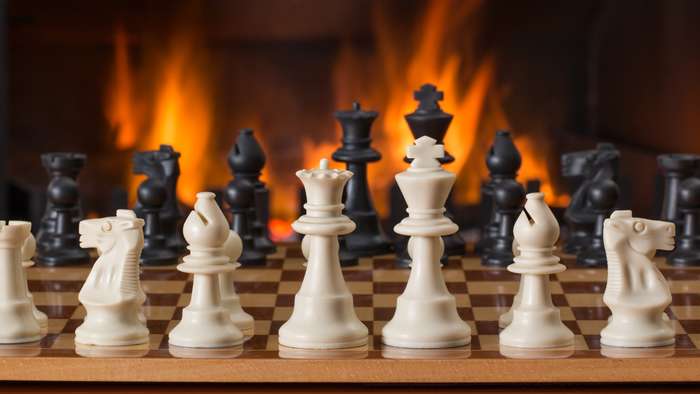
Online chess is the most fun when we’re attacking and winning with brilliant and creative ideas. However, we all have to defend sometimes, and it’s important to get very tough-minded when we’re in that position. It’s not a lot of fun, but sometimes the situation is not as bad as it seems. By exercising care and patience, we can frequently exchange a few pieces, and reduce the position to equality. That’s what happened in this game.
1.e4 e6 2.d4 d5 3.e5 c5 4.Qg4
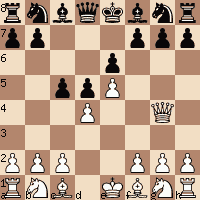
Nimzovich used to play against the French this way. He is considered one of the father figures of modern chess, and his classic My System is considered one of the most influential chess books of all time. But over the last 20 years chess opening theory has evolved a great deal, and the issues with problematic openings have been worked out by grandmasters and computers. A less knowledgeable opponent won’t know how to exploit them, so you can win many fine games with “exciting openings that have a small flaw.” It’s just good to be aware that as you increase in strength, there’s a good chance you’ll want to start playing in tournaments.
make sure your openings are fundamentally sound
With just a little effort, you’ll see good results. That means you’ll start advancing, and then you’ll start playing against stronger opponents, and some of them will know how to “bring the necessary correction to your opening system.
For that reason, if you spend time learning chess openings, I recommend that you make sure your openings are fundamentally sound.
Although 4.Qg4 is no longer part of my repertoire, I played it for a couple of reasons:
- I’m 4–1 with it in tournament play, and won one of my most beautiful games with this move.
- My opponent has been playing the French for over 20 years. He knows the variations extremely well, and I wanted to take him down a road less travelled.
4...Nc6 5.Nf3 Qa5+
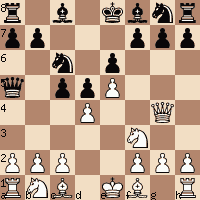
This poses a huge question to the entire variation.
The good news is that my opponent took over 20 minutes to play the move. He told me later that he hadn’t seen it in over 10 years, and spent all that time “remembering the refutation,” and mentally reviewing the variations.
It goes without saying that Hodges is a very serious online chess player ! Nbd2 – There really isn’t a good response.
- After
6.c3, Black captures ond4, and I don’t have compensation for the pawn. - After
6.Bd2, Black plays6…Qb6with a double attack ond4andb2.
6.Nbd2 Nb4
The best move. Black can capture on d4, but White will play Bd3 and 0-0, followed by Nb3 when he wins back the pawn. These ideas represent the heart and soul of the entire 4.Qg4 variation.
White makes it difficult for Black to complete his development by targeting g7 with his queen, and offers a temporary pawn sacrifice. It poses unusual problems that aren’t easy to solve, and prior to this game, my experience in practical play worked out well.
7.Kd1
Although I wasn’t at all happy about the position on the board, I knew I wasn’t technically lost. I was also encouraged by my knowledge that Kd1 is actually played as a standard move in some variations of the Winawer variation.
7...Nh6 8.Qf4
Nxa2 looks very risky, but would have worked out well for Black. It’s a high level move, because a “voluntary self-created-pin” is the kind of thing that can end up causing you to lose games, unless you’ve worked out the details. In this case, after Nb3 … Qa4, Black is threatening c4, winning my Knight on b3. He also prevents dxc4, because my d pawn is now pinned to my own Queen on g4. I would have had to play Rb1, in order to avoid losing the Knight. After that, my opponent’s knight is no longer pinned, he’s won a pawn, and he can continue however he wants.
Almost all my games are against Experts and Masters. They’re tough, and that means that if they win a pawn and I don’t have compensation, then I end up losing a large percentage of those games. I’ve seen Hodges analyze variations with great precision that are way more complicated than …Nxa2.
So why didn’t he play the move ?
Fear Hurts Analysis
Pins are one of the most dangerous weapons on the board
We’ve all learned to fear certain patterns on the board that cause our brain to start waving red danger flags. Pins are one of the most dangerous weapons on the board. Good players have learned to be very wary of allowing them, and that’s a good thing. In other words, Nxa2 was a dangerous move to play. Hodges knew my response would be Nb3, which protects the Rook, and attacks his queen simultaneously. I can almost guarantee he didn’t analyze any further than that. If he put some real work into his analysis, he would have played the move.
Time Trouble Hurts Analysis
It’s also helpful to remember that he spent over 20 minutes on Qa5, and that also factors into the equation. That was my reward for playing an unusual variation. At this point he also wanted to “catch up on the clock,” and so he wasn’t as enthusiastic about reviewing obscure and potentially dangerous complications.
8...c4 9.c3
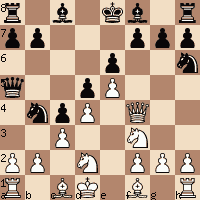
Recurring Themes and Preparatory Moves
After Nxa2 and Kc2 we’re looking at the “voluntary self-created pin” under new circumstances.
The same theme will often emerge in your games on a recurring basis. That means it’s good to be aware that the insertion of a single move by either side can completely change the evaluation.
That’s one way that grandmasters win a lot of their games. They see an attractive idea, do the analysis, and conclude it doesn’t quite work. So rather than give up on the idea, they make a preparatory move (or even a series of preparatory moves) which makes the idea playable. Sometimes preparatory moves are extremely subtle, and the opponent has no idea what’s really happening behind the scenes.
Back to the game …
I was wondering if he should check on a4, and then follow up with Nxa2. On the other hand, it put his Knight in danger once again, and I couldn’t come to a clear conclusion. Hodges also looked at the move and rejected it.
The variation begins with 9… Qa4+ 10.b3 Nxa2 11.Kc2, and the rest is complicated.
I’m giving the best moves, as determined by my computer. It would have taken a world class grandmaster to see these moves over the board.
That means you probably want to just go ahead and check out the final position.
9…Nc6
[9...Qa4+ 10.b3 cxb3 11.Nxb3 Nxa2 12.Kc2 Bd7 13.Bb2 Rc8 14.Nfd2 Bb4 15.Kb1 Nxc3+ 16.Bxc3 Qc6 17.Bb2 Qc2+ 18.Ka2 Bc3 19.Rb1 Ba4 With a small advantage to White.]
10.a3
The Awesome Power of Vertical Lines
in the ending rooks become huge if they can occupy the 7th rank
Let’s think for a moment about the geometry of the game. In chess we’re looking at three types of lines (horizontal, diagonal, and vertical). Bishops get their diagonals immediately. Horizontal lines only become important when the rook or queen radiates control from one side of the board to the other, and there are many games where this never becomes a significant factor. Just be aware that in the ending rooks become huge if they can occupy the 7th rank where they paralyze the opponent, or devour his pawns.
Be very careful about allowing files to open up around your king
Vertical lines are usually the last to open up, but when that happens … the situation often becomes critical when the rook crashes through. Be very careful about allowing files to open up around your king. Many years of experience have taught me the value of taking time to play a move like a3, if it keeps the lines closed around my king. The central files often open quickly, but the rooks usually can’t penetrate because the opponent controls the occupation squares. However, it takes much more preparation to organize the opening of a line on the files close to the side of the board.
A great deal of modern attacking theory has to do with the opening of these lines. There are entire openings that revolve around those themes, especially many variations of the Sicilian defense, where White strives for g4-g5, and Black plays for b5-b4.
Back to the game …
If I had continued developing with Be2, my opponent would have played …b5, and forced open a file close to my King. That’s because now a3 doesn’t stop the advance, since his queen pins the a pawn to my rook If he played …b5 after a3, then I would have calmly replied Rb1. He isn’t able to hurt my king with just his queen and knight, and needs to bring more pieces into play in order to create a dangerous attack. It’s true that a3 weakened my light squares, and with my other pawn at c3, and this was a concern I had to weigh carefully. However, I reasoned that Black wouldn’t be able to exploit those weaknesses. Not only that, they were much less dangerous than the opening of a file.
10...Bd7 11.Be2 Qc7
Always be watching for potential attacks on your center
A good double-purpose move. Hodges makes a5 available for both his knight and his bishop, so they can probe my queenside weaknesses. He also threatens f6, breaking down my center under favorable circumstances. Always be watching for potential attacks on your center. All things considered, your center is the heart and soul of your position. Take measures to preserve and strengthen it, unless something more important is happening.
12.Qg5
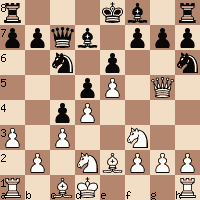
My best move of the game. It prevents Black from playing three different moves: f6, Be7, and 0-0-0.
12...Na5 13.Ke1
Antcipating Black’s next move.
13...Ba4 14.Bd1 Bxd1 15.Kxd1 Rg8 16.h4
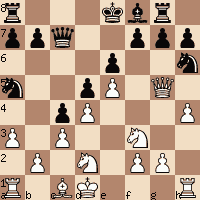
This move is designed to prevent g5 after …Be7. The center is locked, and my opponent has a space advantage on the queenside. I didn’t want to start getting squeezed on the kingside as well. In the words of Karpov, “cramped positions contain the seeds of defeat.” Fight for your share of the space. You need room for your pieces to control squares so you’re able to create play somewhere on the board.
16...Be7 17.Qf4 Qd7
He returns to the light square themes. I’ll be wrestling with them for the rest of the game because of my pawn structure on the queenside.
18.Ke2
Preparing to meet Black’s next move.
18...Qa4 19.Ne1
Preventing penetration of the queen.
19...0–0–0 20.Ndf3
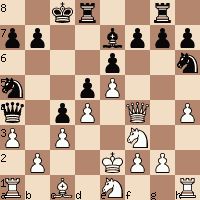
At this point, I offered my opponent a draw and he accepted. He still had a slight edge, but he also had less than 20 minutes on his clock with 20 moves left to make. In other words, he spent 80 minutes on the first 20 moves, searching hard for ways to break down my position. Now he was running low on time, and didn’t feel like dealing with it any more. That’s the value of Heroic Defense!
Conclusion
Because of a bad opening, I ended up defending after 5…Qa5 for the entire rest of the game.
By the way …
I have a large games database with players all rated over 2400. In that database, less than 50% of them found …Qa5. It’s not intuitive, and you almost have to know the theory in order to find the move.
defending becomes an opportunity to build character and improve a vital skill
From one perspective, it was an ugly game from the White side of the board. There was a time in my chess career I would have disliked the whole thing, regardless of the result. However, I’ve grown since then, and have come to understand that defense is a natural part of the game. I still prefer attacking and playing combinations, and have modelled my style and opening repertoire in order to create those opportunities. However, we can take pleasure in “doing what it takes” and proving ourselves equal to the task at hand. From that perspective, defending becomes an opportunity to build character and improve a vital skill.
I still play very close to the edge. That’s because when I choose to sit down at the board it’s never about “making sure I don’t lose.” I’m always looking to win.
Most important of all, here’s the main reason I play chess… There’s no game like it that gives us the opportunity to exercise our creativity and imagination in a competitive situation where every move counts.
That’s exactly what makes online chess so exciting!
